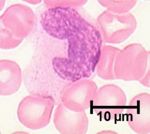Monocytes
Introduction
Monocytes are the largest leukocytes. They have a large indented nucleus, few granules and constitute about 5% of circulating leukocytes. Monocytes are precursors to a number of cells that make up the mononuclear phagocytic system. Developing in the bone marrow, monocytes migrate into the circulation where, after approximately three days, they migrate into tissues and differentiate.
Development
Monocytes develop from the bi-potential CFU-GM stem cell during leukopoiesis.
When monocytes leave the blood stream they then differentiate into a number of cells (all are macrophages):
- Connective tissue histiocyte
- Alveolar macrophage
- Peritoneal macrophage
- Kupffer cell of liver
- Melanophage of skin
- Lipophage
- Osteoclasts in bone
- Microglial cell in bone & brain
- Specialised histiocytes
- Epithelioid cell
- Histiocytic giant cell
- Langhan’s cell
- Foreign body
- Touton
Action
During inflammation chemokines attract monocytes which migrate out of blood vessels into the damaged tissue, where they differentiate into cells of the mononuclear phagocytic system.
Monocytes can live for months to years in the circulation.
Monocytes are referred to as macrophages once they enter a tissue by diapedesis.
Monocytes/macrophages act as phagocytes, removing particular antigens. They also act as antigen presenting cells to take up, process and present antigen to T cells.
In pathology

